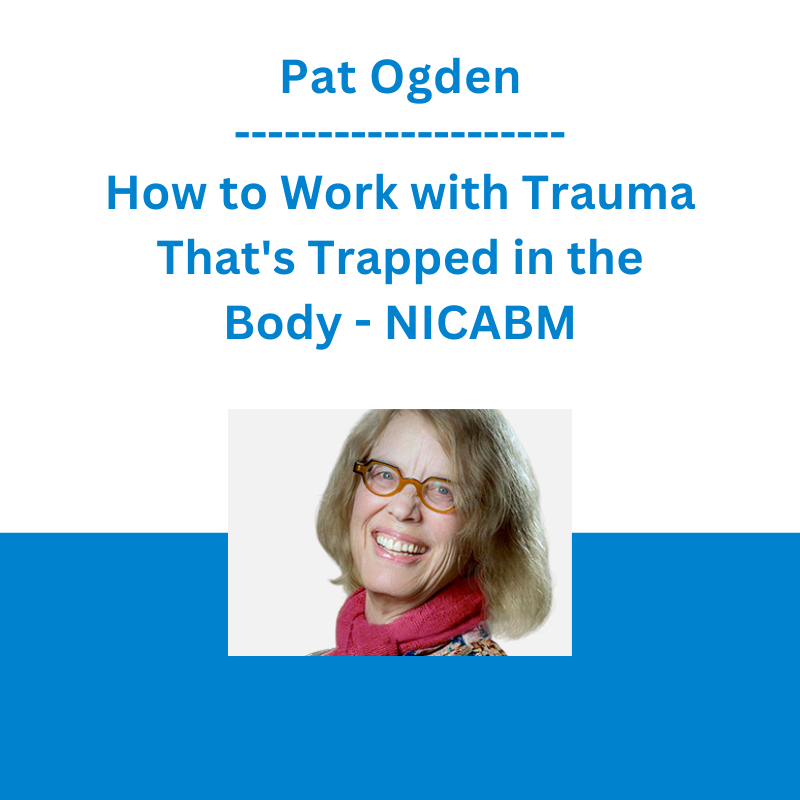*** Proof of Product ***
Exploring the Essential Features of “Pat Ogden – How to Work with Trauma That’s Trapped in the Body – NICABM”
How to Work with Trauma That’s Trapped in the Body
Feeling safe can be a daily challenge for our traumatized clients.
They might feel anxious and upset without knowing why. What’s worse, they often become afraid to rely on their instincts.
That’s because trauma disrupts a person’s innate intelligence.
But by working with the body, we can help them find it again.
Pat Ogden, PhD is a master when it comes to “reading the body” in the treatment of trauma.
In this short course, she’ll explain how she works with movement, posture, and attachment patterns to help patients heal.
How to Work with Trauma That’s Trapped in the Body
Pat Ogden, PhD
- How to Manage the Arousal and Integration Problems Caused by Trauma
- How to Help Your Patients Safely Expand Their Window of Tolerance
- One Way to Use Movement to Treat the Immobilization Response
- How to Use Polyvagal Theory to Help a Client Feel Safe
- How Attachment Patterns Influence the Body
- How to Apply Polyvagal Theory to Help Regulate Arousal
- One Approach to Working with Insecure Attachment
- How Trauma Is a Failure of Integration
- Why Working in the Present Can Be More Useful Than Retelling the Trauma “Story”
Register Here
and get the video, audio, transcript, TalkBack, Next Week in Your Practice, and QuickStart Guide
Here’s What You’ll Get:
Everything is yours to keep forever in your professional library
- Downloadable video and audio to watch or listen to when it’s convenient for you
- TalkBack Segment to distill key ideas (this is where we “land” the session)
- Next Week in Your Practice video to give you concrete strategies to use with patients
- Printable QuickStart Guide to make review and action simpler than ever
- Professionally-formatted transcript of the session
- Downloadable bonus to help you work more effectively with trauma
You’ll Get This Extra Bonus Session:
Why You Have to Understand Dissociation to Treat Trauma
with Kathy Steele, MN, CS
- Recognizing and treating Mindflight – A phobia of inner experience
- Take-home exercises for working with the triggers of dissociation
- How to help patients learn to recognize trauma-related triggers
- Why distinguishing past from present is a critical element of healing
- The phases of treatment – integrating Mindflight into Mindsight
Pat Ogden, PhD is a pioneer in Somatic Psychology; Founder and Director of Sensorimotor Psychotherapy Institute (SPI); Co-founder of the Hakomi Institute; Author of Sensorimotor Psychotherapy: Interventions for Trauma and Attachment
This Program Can Change the Way You Practice
I so appreciated Pat’s discussion of the hypo-arousal state [and] ideas for working with it . . .
“I so appreciated Pat’s talk, and the discussion of the hypo-arousal state, ideas for working with it, and its similarity in appearance to depression, as well as the different attachment styles, and the attention to a person’s procedural tendencies. I have a client in mind who has done a lot of work through EMDR on childhood trauma and now we are looking at current relationships. I will keep all this in mind as I look to her body as a resource for moving forward.”
Holly Bradley, Counselling Care
British Columbia, Canada
I will continue to use this . . .
“Great program with Pat Ogden! I so appreciate the work she has done, and continues to do. I will continue to use this information and work with my own mindfulness of each client’s body expression of what is happening on an emotional level.”
Diane Green, Private Practice Counselor
Enumclaw, WA
Course Director
Ruth Buczynski, PhD
Dr. Ruth Buczynski is a licensed psychologist and founder and president of The National Institute for the Clinical Application of Behavioral Medicine (NICABM). NICABM helps physicians, nurses, psychologists, social workers, and counselors – practitioners who have some of the most significant and life-changing missions on the planet – provide cutting-edge, research-based treatment strategies to their patients. For more than 25 years, NICABM has offered accredited training and professional development programs to thousands of practitioners worldwide.
Why the Transcript Is Essential:
- The transcript makes it easy to go back and double check concepts, citations and names that are mentioned
- We put in a table of contents to make it easy for you to find the exact part of the webinar you need
- Having the concepts already written allows you to take notes on how you’re going to use the ideas rather than transcribing the ideas
- Some people simply learn better by reading than by listening or watching
- You will be able to print out and share techniques presented in the session with your patients
Please see the full list of alternative group-buy courses available here: https://lunacourse.com/shop/









